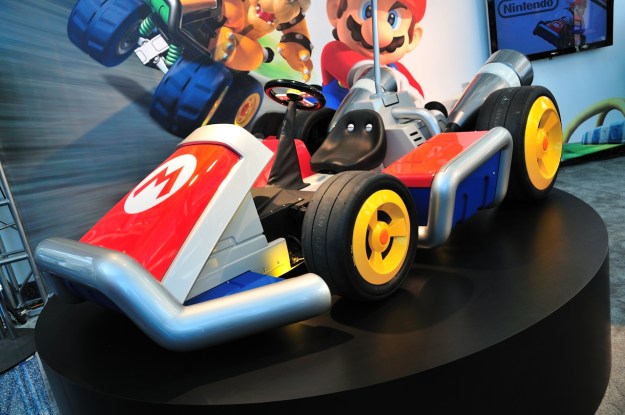 We’ve brought some approximations of real-world Mario Kart experiences to your attention in the past, but when it comes to replicating Mario’s wheels, there’s never been anything quite like this.
We’ve brought some approximations of real-world Mario Kart experiences to your attention in the past, but when it comes to replicating Mario’s wheels, there’s never been anything quite like this.
Nintendo and West Coast Customs unveiled a pair of functioning, authentic Mario Karts — Mario’s signature ride and Luigi’s “Bumble V” kart — at the Los Angeles Auto Show this week.
Built as part of an upcoming episode of the West Coast Customs reality show, the front-wheel drive cars are equipped with 18-inch rear wheels and disc brakes. Luigi’s kart even has a propeller add-on for traveling through water. (Sadly, they don’t actually travel underwater.)
You can read more about the karts in the press release below, or just ogle the images at AutoBlog, which has some pretty great shots of the karts.
Nintendo Drives Home Fun at the LA Auto Show with Life-Size Mario Karts
West Coast Customs Builds Karts Based on Classic Video Game Franchise
LOS ANGELES–(BUSINESS WIRE)– Ever wanted to see a real-life kart from Nintendo’s hit Mario Kart™ series outside of the Mushroom Kingdom? Nintendo has teamed up with West Coast Customs to create life-size models of two karts – one for Mario™ and one for Luigi™ – from the upcoming Mario Kart 7 video game for the portable Nintendo 3DS™ system. These unique electric vehicles were unveiled today at the LA Auto Show, where they will be on display Nov. 18-27 in the lobby of the West Hall of the Los Angeles Convention Center. Visitors attending the show will be able to take photos of the karts, sample the Mario Kart 7 game before its Dec. 4 launch and participate in multiplayer game play.
Additionally, members of the GameStop® PowerUp Rewards™ program will have the opportunity to claim the Mario Kart as his or her own as part of the monthly Epic Reward Giveaway™ program. To be eligible for an Epic Reward Giveaway entry, members must make a purchase or trade at their local GameStop or on GameStop.com during the month of December. PowerUp Rewards Pro™ Members automatically get two entries with purchase. The lucky winner will be announced in February; for more information, visit http://www.poweruprewards.com.
West Coast Customs is known for TV shows such as the classic Pimp My Ride on MTV and the current show Inside West Coast Customs on the Velocity Network. The company has re-created two vehicles from Mario Kart 7: the classic Mario Standard kart, complete with glider attachment for soaring through the air, and the Luigi Bumble V kart, which resembles a bumblebee and features a rear propeller for underwater navigation.*
“Mario karts offer more fun per mile than any other vehicle,” said Nintendo of America President Reggie Fils-Aime. “Mario Kart 7 is a perfect example of the many great games Nintendo has lined up for the holidays.”
“We’ve played Mario Kart games for years, so it’s a dream come true to bring these karts to life,” said West Coast Customs CEO Ryan Friedlinghaus. “We think people will be blown away by seeing these cool video game vehicles in person.”
In early 2012, an episode of Inside West Coast Customs will show how West Coast Customs and Nintendo worked together to make these video game vehicles a reality.
For more information about Mario Kart 7, visit http://www.mariokart7.com. For more information about West Coast Customs, visit http://www.westcoastcustoms.com.
Remember that Nintendo 3DS features parental controls that let adults manage the content their children can access. For more information about this and other features, visit http://www.nintendo.com/3ds.




